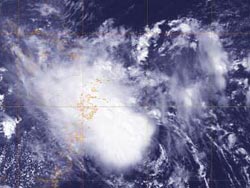NASA Catches Short-lived Northwestern Pacific Ocean Tropical Depression 13W

Before TD13W dissipated, NASA's Aqua satellite captured an image of the short-lived storm on Aug. 18 that showed the depression still had a circulation and thunderstorms around its center. <br>Image Credit: NRL/NASA<br>
TD13W was “born” at 1500 UTC/11 a.m. EDT on Aug. 17 with maximum sustained winds near 25 knots. Later that day at 2100 UTC/5 p.m. EDT, the Joint Typhoon Warning Center issued its final bulletin on the depression.
At that time it was located near 28.0 north latitude and 126.0 east longitude, about 109 nautical miles northwest of Kadena Air Base, Japan.
Before TD13W dissipated, the MODIS instrument that flies aboard NASA's Aqua satellite captured an image of the short-lived storm on Aug. 18 that showed the depression still had a circulation and thunderstorms around its center.
On Sunday, Aug. 18, while Tropical Depression 12W had strengthened into Tropical Storm Trami, nearby Tropical Depression 13W had already weakened and by Aug. 19 became a remnant low pressure area.
Trami was located to Tropical Depression 13W's southeast. Because TD13W was to Trami, the tropical storm basically took the life out of TD13W.
Text credit: Rob Gutro
NASA's Goddard Space Flight Center
Media Contact
All latest news from the category: Earth Sciences
Earth Sciences (also referred to as Geosciences), which deals with basic issues surrounding our planet, plays a vital role in the area of energy and raw materials supply.
Earth Sciences comprises subjects such as geology, geography, geological informatics, paleontology, mineralogy, petrography, crystallography, geophysics, geodesy, glaciology, cartography, photogrammetry, meteorology and seismology, early-warning systems, earthquake research and polar research.
Newest articles

Red light therapy for repairing spinal cord injury passes milestone
Patients with spinal cord injury (SCI) could benefit from a future treatment to repair nerve connections using red and near-infrared light. The method, invented by scientists at the University of…

Insect research is revolutionized by technology
New technologies can revolutionise insect research and environmental monitoring. By using DNA, images, sounds and flight patterns analysed by AI, it’s possible to gain new insights into the world of…

X-ray satellite XMM-newton sees ‘space clover’ in a new light
Astronomers have discovered enormous circular radio features of unknown origin around some galaxies. Now, new observations of one dubbed the Cloverleaf suggest it was created by clashing groups of galaxies….





















